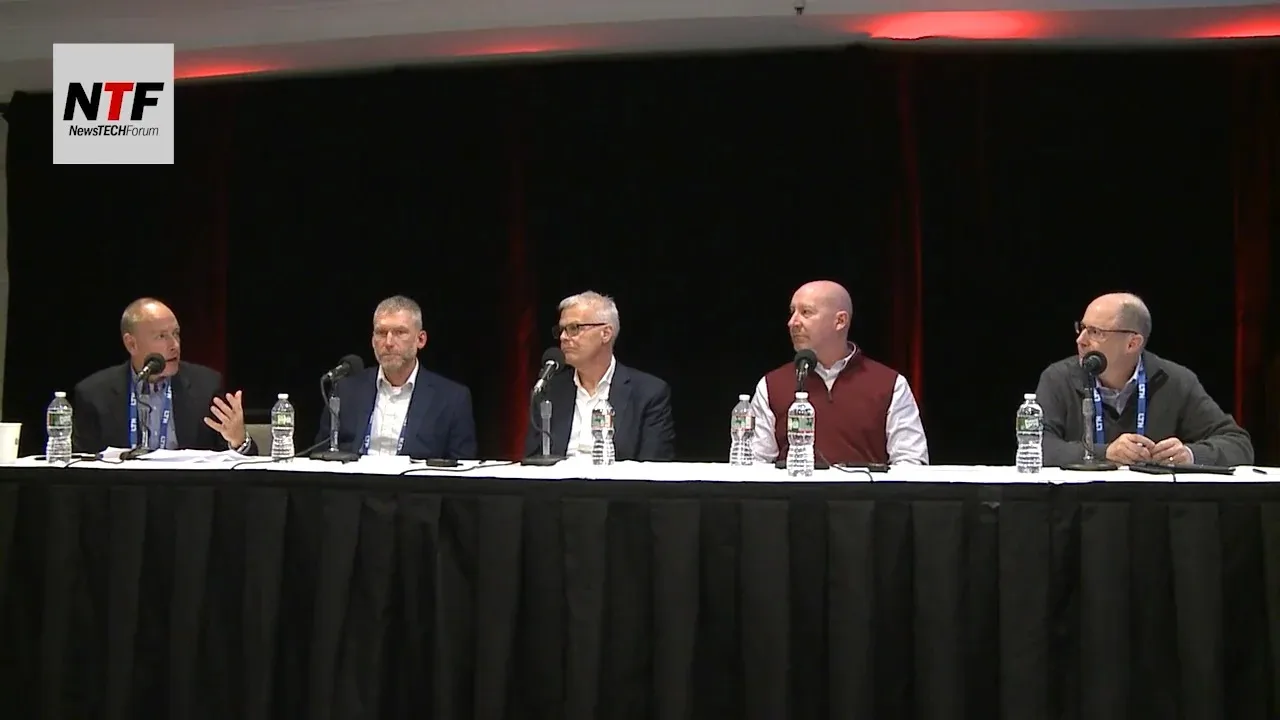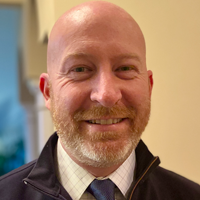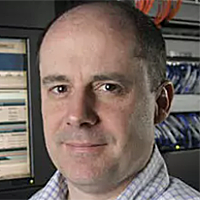
From Remote News Producers To Camera-To-Cloud Workflows, Broadcasters Chase Agility In Studio And Field

As they seek to meet the ever-increasing demand for content, broadcasters are striving for more efficiency in all aspects of news production, including studio presentation, newsroom workflows and field operations. Flexibility and speed are key drivers for any implementation of new technology, said top executives who gathered this week at TVNewsCheck’s NewsTECHForum in New York City, whether that is on-set displays or a contribution path from the field.
Big Changes At CNBC

Glen Dickson
CNBC unveiled its first graphics redesign in a decade this week, with a new logo and an updated ticker. But the new look builds on changes the financial news network has been gradually making to its studio presentation over the past three years, said Steve Fastook, SVP of technical and commercial operations for CNBC. Since 2020, the network has integrated high-pixel-density, movable LCD displays with scenery and AR graphics in studios at its Englewood Cliffs, N.J., headquarters and at both the New York Stock Exchange and NASDAQ in Manhattan.
The LED displays can be easily configured to accommodate interviews with both studio and remote guests, allowing traders to speak from their trading floors while still appearing to be on-set. And AR graphics such a 3D representation of a stock chart give talent a more dynamic way to present information, said Fastook, speaking on the panel “Agility in News Production,” moderated by this reporter.
“It’s all about presenting data in an elegant and beautiful fashion,” Fastook said. “And this is where AR and high-quality LCD screens are everything; it’s revolutionized everything we do. I don’t think I’ll ever put a brand on a set again. Right now, I have one brand and one desk left, and it’s the CNBC Peacock. Everything else is completely electronic. Because the screens are affordable, they’re configurable, because the form factor is small. So, I can curve them, I can make strips, I can make them vertical or horizontal. It’s really amazing stuff.”
Fox Television Stations Create Options
WTTG Washington and WAGA Atlanta are taking the lead for Fox Television Stations in experimenting with AR and XR graphics, said Erik Smith, VP of news operations and technology, Fox Television Stations (FTS), as the group seeks new options for the abundant content its stations produce each day for both linear and digital distribution.

Erik Smith (LinkedIn)
“We are a live-based company; WTTG is doing over 15 hours of live linear content a day,” Smith said. “Clearly, we’re trying to support Fox Local and other initiatives for our company in the digital space, so we need flexibility in our studios. We want to create compelling storytelling opportunities across all of those platforms.”
FTS uses a hub-and-spoke approach for its graphics operations, with Chyron as the base technology. WTTG has invested in the Chyron VSAR virtual graphics product, which is based on the Unreal platform and already works with its existing Chyron infrastructure. WAGA has taken a different approach and is focused on augmented reality using The Weather Company’s MaxReality product. Neither station has those systems up and running yet and they are both currently in the setup phase.
Smith said that call-letter stations can be rightly viewed as “the last frontier” for AR and XR graphics, which have been widely adopted for sports coverage as well as by several national newscasts. The biggest challenge is in personnel. While Fox’s graphics hub has “phenomenal artists” and there is also a local artist at each station, that doesn’t mean they have specific expertise in 3D modeling and Unreal Engine rendering, which is what most AR/XR systems today run on. There are plenty of freelance artists with Unreal expertise, Smith noted. But most of them approach it from a gaming perspective and not a broadcast background, and they don’t have expertise with NRCS integration or MOS.
“It’s really about getting the right human resources to support the content,” Smith said. “Because you don’t want to farm it all out, you want to be able to build it in-house and keep it close. So, that’s a challenge that we continue to work through. It will continue to grow and there will be more opportunities and more people to support it, but it’s a challenge right now.”
Remote News Producers At Gray
On the other hand, new IP-based production tools are helping to solve personnel challenges for Gray Television, which like other groups has found it difficult to attract and retain quality employees, said Clint Moore, director of broadcast operations for Gray Television. After most employees shifted to remote work during the COVID-19 pandemic, Gray found that many wanted to continue to work from home after the pandemic eased and it was safe to return to stations.
While there was a “big debate” about whether Gray should allow that or not, Moore said, a couple of stations fully embraced the work-from-home model.

Clint Moore
“They’ve got producers that work for them that turn shows daily that don’t even live in the same city, in some situations they’re states or even time zones away,” he said. “We looked at that on a corporate level, too, and said how can we help these stations? A lot of stations are struggling, they’re always recruiting, and they need help on a corporate level.”
So, Gray formed a new group of a dozen corporate employees called “Remote News Producers” that fully work from home in different time zones and provide an additional resource that stations can tap to produce daily newscasts. Each remote news producer has a group of stations in the time zone in which they live, and they pitch in to help stations by filling in for employees who are sick, on maternity leave or on vacation. Some days they might produce an entire newscast, while on other days they simply help out as an associate producer.
Each remote news producer is responsible for having a “certain footprint of equipment” at their home, Moore said, with a station providing the rest so they can efficiently connect to do their work. The move has been a big success for Gray, with one remote news producer even winning an Emmy for her work.
“It’s been really helpful for us, and the stations have really appreciated it,” Moore said. “And it allows us to attract a higher caliber of employee, because you can get someone who’s highly qualified who can live where they want to live and still produce news.”
Gray has also extended at-home work to directing through the use of production automation systems like Ross OverDrive. That is a workflow that also started during the pandemic and persisted at a few stations, sometimes in combination with a remote news producer.
“In a situation where in an automated control room we [would] have anywhere from two to four people in there for a newscast, now you can just have one person at the station watching everything, making sure everything is doing everything it’s supposed to,” Moore said. “And everybody else is working remotely to direct and produce from home.”
Sinclair’s Camera-To-Cloud Workflows
For its part, Sinclair is looking to take its news production into the public cloud. The group has been working over the past year with Sony and other vendors on a “camera-to-cloud workflow” where video captured by a field camera is ingested directly into the cloud and then immediately available for editing through a cloud-based editor.

Ernie Ensign
“The idea there is having access to content as quickly as possible, and moving us into this mindset of gather, report, gather, report,” said Ernie Ensign, AVP, news technology and operations for Sinclair. “With all of the content consumption that happens every day, we can’t wait for a story to be produced, to have a photographer edit in the field and send it back in. So, the mindset is to get content in as fast as possible, with metadata.”
Sinclair has an “assignment queue” within its newsroom computer system that’s linked to the camera, so a producer can attach a label to a story that will stay with the video captured in the field. Ensign said that stations have embraced the new workflow and that Sinclair plans to expand it further next year.
There still are some challenges with the camera-to-cloud system, including workflow overlaps with existing bonded cellular devices, which send some content quickly to the cloud, but not everything. But the bigger issue is the overall reliability of cellular coverage.
“You can’t build a workflow and it only works some of the time,” Ensign said. “It’s got to be fairly resilient. And I think each of the cellular providers have a different strategy, in whether they’re trying to target bandwidth or a more blanketed coverage across the country.”
Sinclair has had numerous conversations with cellular providers about making their coverage more robust and is also experimenting with a new compact Live U bonded device that promises to transmit content more quickly.
“It’s a work in progress, but I think as the codecs in the cameras get better, we can increase the quality and reduce the bitrate,” Ensign said. “I think that’s going to further improve those workflows.”
The other area Sinclair is exploring is using cloud-based switchers to support a full production control room (PCR) in the cloud. That effort is not aimed at live daily newscasts at this point, but instead for remote productions of events like political debates, parades and town halls.
“I’m not sure that [the] cloud is completely ready for 16 hours of live news a day, and that the business models completely work,” Ensign said. “But certainly, all these other types of productions where we roll a production truck, the set up and tear down take a lot of time and effort and energy and engineering resources. And we think there’s some better ways and better tools out there to turn those into more cloud-related productions. Those so far have been very successful, and we’ve gotten good engagement and good endorsement from our newsrooms.”
Wider Cloud Adoption
Smith said Fox is also working with LiveU on a cloud-based ingest system where metadata flows from the NRCS at a station, through the LiveU ecosystem, and then back into the Bitcentral MAM. Fox is also evaluating cloud-based production switchers as control room replacements but is currently focused on productions for digital properties or linear coverage of “pop up events” where it doesn’t want to use an entire control room.
“Some of those cloud production tools you can spin up and use on an as-needed basis really fit that model for us,” Smith said. “We’ve looked at multiple vendors on that.”
In that vein, Fox’s digital team is currently using TVU Networks’ Channel playout system and Producer production system, and FTS has also tested LiveU Studio and Grabyo.
CNBC is also using cloud production tools today, not for its primary broadcast but for coverage of special events, which the network organizes and offers as a subscription service. Remote coverage is typically accomplished by sending a producer equipped with a PC and a few cameras.
“Our events business is almost completely through cloud control,” Fastook said.
Gray is looking at cloud-based production but definitely in more of a hybrid approach, Moore said, particularly given the vulnerability of some stations to severe weather events.
“We’re not going to jump all-in on the cloud right away, it’s too risky,” Moore said. “We have a lot of stations in the footprint of along the Gulf and along the coast, and for those stations it’s not if you lose connectivity, it’s when.”
When it comes to improved connectivity, both Fox and Sinclair are interested in using 5G network slicing with dedicated bandwidth if and when that becomes available from carriers. And both groups have recently been making use of low-earth-orbit [LEO] satellites like Starlink as a new connectivity option, with Fox gradually adding Starlink gear to its news trucks to go along with existing bonded equipment.
While both Smith and Ensign view Starlink as another “tool in the toolbox,” Ensign said it has already proved invaluable for Sinclair for remote coverage.
“Starlink did save us at an Ohio State football game a couple of months ago,” Ensign said. “We had very limited bandwidth from where we were, and Starlink was the difference in still getting on the air.”
Read more coverage of NewsTECHForum 2023 here.
Watch this session and all the NewsTECHForum 2023 videos here.
































Comments (0)